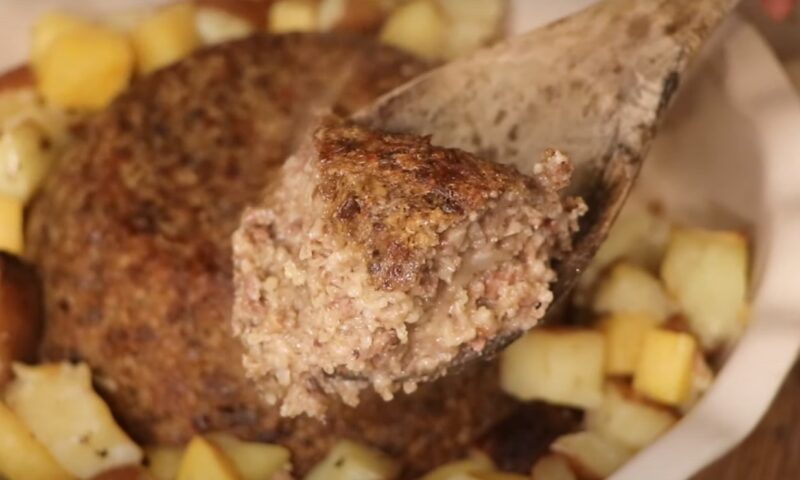Haggis, the iconic Scottish dish, is enveloped in mystery and fascination, often leaving many curious about its unique taste and texture.
Today, I will uncover the enigmatic flavors of haggis, offering a comprehensive guide to realize what sets this traditional dish apart.
The Origin and Preparation

Haggis has long been a staple of Scottish cuisine, often associated with Burns Night celebrations. Its origins are steeped in history, tracing back to a time when hunters and gatherers used every part of their catch.
The dish is a savory pudding containing sheep’s pluck (heart, liver, and lungs), minced with onion, oatmeal, suet, spices, and salt, encased in the animal’s stomach, though now often in an artificial casing instead.
Preparation Methods That Influence Flavor
The preparation of haggis is an art that significantly influences its taste. Traditionally, the ingredients are mixed and then simmered for several hours.
This slow cooking process melds the flavors together, creating a rich and hearty taste profile. Variations in spice blends and cooking techniques can also add unique twists to the traditional flavor.
Modern Takes on an Ancient Recipe
In recent years, contemporary chefs have experimented with haggis, introducing new ingredients and methods.
Vegetarian and vegan versions, substituting meat with lentils or beans, are also popular. These modern adaptations cater to a wider audience, allowing more people to appreciate this Scottish delicacy.
The Taste Profile

Describing the taste of haggis can be challenging as it has a complex flavor profile. It is often compared to a rich, nutty sausage or a savory mince with a peppery and earthy undertone.
The oatmeal in the mixture provides a soft, crumbly texture, contrasting with the meat’s denseness.
The Role of Spices
Spices play a crucial role in this dish, with each recipe having its unique blend. Common spices include allspice, nutmeg, and pepper, which give haggis its distinctive warmth and depth. The balance of spices can greatly affect the overall taste, making each haggis experience slightly different.
The Impact of Accompaniments on Flavor
Haggis is traditionally served with ‘neeps and tatties‘ (turnips and potatoes), which complement its rich flavor.
Whisky sauce is another common accompaniment, adding a smooth, boozy note that enhances the dish’s overall taste. These sides not only add to the flavor experience but also provide a balance to the dish’s intensity.
Nutritional Value and Dietary Considerations

Haggis is a nutrient-dense food, high in protein and iron, thanks to its organ meat content. It’s also a good source of fiber due to the oatmeal.
However, it can be high in fat and cholesterol, making it more suitable for occasional indulgence rather than a daily diet staple.
Dietary Restrictions and Alternatives
For those with dietary restrictions, alternatives to traditional haggis are available. Gluten-free versions cater to those with celiac disease or gluten intolerance, while vegetarian and vegan variations provide options for plant-based diets.
These alternatives aim to mimic the traditional flavors while accommodating dietary needs.
Balancing Tradition and Health
While haggis is a traditional dish, it’s important to consider its health implications. Moderation is key when enjoying it, especially for individuals with dietary restrictions or health concerns.
Balancing haggis with healthier sides or choosing leaner versions can make it a more health-conscious choice.
Cultural Significance and Global Perception
Haggis holds a special place in Scottish culture, symbolizing national pride and tradition. It’s central to Burns Night celebrations, honoring the poet Robert Burns.
The ‘Address to a Haggis’ recited during these events highlights its cultural importance.
Global Reception and Misconceptions
Globally, haggis often faces misconceptions, mainly due to its unusual ingredients. However, those who venture to try it are frequently surprised by its savory, satisfying flavor. Haggis has gradually gained appreciation worldwide, with exports and international celebrations increasing its popularity.
The Evolution of Haggis in the Culinary World
In the culinary world, this dish has evolved from a traditional Scottish dish to a global delicacy.
Chefs around the world have embraced it, creating fusion dishes and innovative interpretations. This evolution showcases the dish’s versatility and enduring appeal.
Pairing With Drinks

Whisky is the traditional drink of choice when it comes to pairing with haggis. The robust, smoky flavors of a good Scotch whisky complement the rich and spicy taste of this dish.
Each whisky offers different notes, from peaty to fruity, providing a range of pairing possibilities that can enhance the haggis experience.
Alternative Drink Pairings
While whisky is traditional, haggis can also pair well with other beverages. Red wines, particularly those with earthy notes, can complement the meaty, spicy flavor of haggis.
For those preferring non-alcoholic options, a rich, dark ale or a spicy ginger beer can offer a similar depth and complexity.
The Importance of Balance in Pairings
The key to a successful pairing is balance. A drink that’s too strong can overpower the haggis, while something too light might be overshadowed.
The aim is to find a beverage that complements and enhances the dish without dominating the palate.
A Place in Contemporary Cuisine

Innovative chefs have begun incorporating haggis into a variety of dishes, creating a fusion cuisine that brings Scottish tradition into the modern culinary world.
Haggis tacos, burgers, and even pizza are just a few examples of how this traditional dish is being reimagined.
Global Delicacy
The rise of global cuisine has seen haggis making appearances on menus far from Scotland. Its unique flavor profile has intrigued chefs and diners worldwide, leading to a greater appreciation and understanding of this Scottish delicacy.
The Impact on Food Trends
Haggis is more than just a dish; it’s a part of Scotland’s identity. Its emergence in global cuisine reflects a broader trend of exploring and valuing traditional foods from different cultures, contributing to a more diverse and exciting culinary landscape.
Cooking and Serving at Home
Cooking haggis at home can be a rewarding experience. For those using a traditional haggis, steaming or boiling is the preferred method.
It’s important to ensure that the dish is cooked thoroughly and evenly. Serving it with the classic neeps and tatties ensures a traditional experience.
Creative Ways to Serve It
Beyond the traditional presentation, haggis can be served in creative ways. It can be used as a stuffing for poultry or as a filling for pies and pastries. These variations allow for a broader range of textures and flavors, making haggis a versatile ingredient in the kitchen.
Haggis for Special Occasions
While associated with Burns Night, haggis can be enjoyed on various occasions. It can be a centerpiece for a Scottish-themed dinner party or a special treat for a festive meal. The key is to present it in a way that honors its tradition while fitting the occasion.
FAQs
Can haggis be frozen and reheated?
Yes, it can be frozen. To reheat, thaw it completely and then warm it in an oven or on the stovetop until it’s heated through.
Is haggis safe for pregnant women?
Pregnant women should avoid it due to the presence of the liver, which is high in vitamin A and can be harmful in large amounts during pregnancy.
How long does haggis last in the refrigerator?
Properly stored, cooked variation can last for about 3 days in the refrigerator. It should be covered or stored in an airtight container.
Can haggis be made with meats other than sheep?
Yes, some variations can be made using beef or venison. The traditional recipe, however, calls for sheep organs.
Are there any specific health benefits associated with eating haggis?
It is rich in iron and protein and also provides a good source of fiber. However, it should be consumed in moderation due to its high fat content.
Is haggis typically spicy or hot?
Traditional variation is not typically spicy or hot. It has a savory and slightly peppery flavor, but it’s not characterized by heat like chili peppers would provide.
Final Words
Haggis, with its rich history and unique taste, offers a culinary adventure for those willing to explore beyond the conventional.
Its complex flavors, nutritional value, and cultural significance make it a dish worth trying, whether in its traditional form or through modern adaptations.
As we’ve discovered, haggis is more than just a dish; it’s a symbol of Scottish heritage and a testament to the richness of culinary diversity.






